I am trying to figure out a way to customize the scrollbars for QListWidget to have the scrollbars above and below the QListWidget instead of the normal vertical and horizontal scrollbars.
Please check out my example below if you don't understand what I mean.
In the example below I use QPushButtons with QTimers controlling the scrolling in place of the scrollbars but what I am looking for are scrollbars like the ones in QMenu when menu scrolling is enabled.
If that is not an option, I am wondering if there is a scrollbar signal or something that I could try to use to know when the scrollbars are normally activated? That way I can show/hide the buttons as needed. Thanks.
import sys
from PyQt5.QtCore import pyqtSignal, QTimer, Qt
from PyQt5.QtGui import QPainter
from PyQt5.QtWidgets import QWidget, QPushButton, QVBoxLayout, \
QApplication, QStyle, QListWidget, QStyleOptionButton, QListWidgetItem
class UpBtn(QPushButton):
mouseHover = pyqtSignal()
def __init__(self):
QPushButton.__init__(self)
self.setMouseTracking(True)
self.timer = QTimer()
def paintEvent(self, event):
painter = QPainter()
painter.begin(self)
opt = QStyleOptionButton()
self.initStyleOption(opt)
self.style().drawControl(QStyle.CE_ScrollBarSubLine, opt, painter, self)
painter.end()
def startScroll(self):
self.mouseHover.emit()
def enterEvent(self, event):
self.timer.timeout.connect(self.startScroll)
self.timer.start(120)
def leaveEvent(self, event):
self.timer.stop()
class DwnBtn(QPushButton):
mouseHover = pyqtSignal()
def __init__(self):
QPushButton.__init__(self)
self.setMouseTracking(True)
self.timer = QTimer()
def paintEvent(self, event):
painter = QPainter()
painter.begin(self)
opt = QStyleOptionButton()
self.initStyleOption(opt)
self.style().drawControl(QStyle.CE_ScrollBarAddLine, opt, painter, self)
painter.end()
def startScroll(self):
self.mouseHover.emit()
def enterEvent(self, event):
self.timer.timeout.connect(self.startScroll)
self.timer.start(120)
def leaveEvent(self, event):
self.timer.stop()
class Window(QWidget):
def __init__(self):
super(Window, self).__init__()
self.layout = QVBoxLayout()
self.layout.setContentsMargins(0, 0, 0, 0)
self.layout.setSpacing(0)
self.upBtn = UpBtn()
self.upBtn.setFixedWidth(230)
self.layout.addWidget(self.upBtn)
self.listWidget = QListWidget()
self.listWidget.setFixedWidth(230)
self.listWidget.setHorizontalScrollBarPolicy(Qt.ScrollBarAlwaysOff)
self.listWidget.setVerticalScrollBarPolicy(Qt.ScrollBarAlwaysOff)
self.layout.addWidget(self.listWidget)
self.downBtn = DwnBtn()
self.downBtn.setFixedWidth(230)
self.layout.addWidget(self.downBtn)
self.setLayout(self.layout)
self.upBtn.clicked.connect(self.upBtnClicked)
self.upBtn.mouseHover.connect(self.upBtnClicked)
self.downBtn.clicked.connect(self.downBtnClicked)
self.downBtn.mouseHover.connect(self.downBtnClicked)
for i in range(100):
item = QListWidgetItem()
item.setText("list item " + str(i))
self.listWidget.addItem(item)
def upBtnClicked(self):
cur = self.listWidget.currentRow()
self.listWidget.setCurrentRow(cur - 1)
def downBtnClicked(self):
cur = self.listWidget.currentRow()
self.listWidget.setCurrentRow(cur + 1)
if __name__ == '__main__':
app = QApplication(sys.argv)
window = Window()
window.show()
sys.exit(app.exec_())
EDIT:
Here is an example image for what I am talking about. This is a scrollable QMenu.
EDIT:
Scrollable QMenu code.
Uncomment the commented parts to get a fixed size like in the image. Normally Qmenu scrolling only works when the menu items exceed the screen height. I am just looking for the top and bottom hover style scrolling but to be used in QListWidget.
import sys
from PyQt5.QtCore import QPoint, QEvent
from PyQt5.QtWidgets import QWidget, QPushButton, QVBoxLayout, \
QApplication, QAction, QMenu, QProxyStyle, QStyle
class MyMenu(QMenu):
def event(self, event):
if event.type() == QEvent.Show:
self.move(self.parent().mapToGlobal(QPoint(-108, 0)))
return super(MyMenu, self).event(event)
# class CustomStyle(QProxyStyle):
# def pixelMetric(self, QStyle_PixelMetric, option=None, widget=None):
# if QStyle_PixelMetric == QStyle.PM_MenuScrollerHeight:
# return 15
# if QStyle_PixelMetric == QStyle.PM_MenuDesktopFrameWidth:
# return 290
# else:
# return QProxyStyle.pixelMetric(self, QStyle_PixelMetric, option, widget)
class MainWindow(QWidget):
def __init__(self, parent=None):
super(MainWindow, self).__init__(parent)
self.layout = QVBoxLayout()
self.btn = QPushButton("Button")
self.btn.setFixedHeight(30)
self.btn.setFixedWidth(100)
self.myMenu = MyMenu("Menu", self.btn)
self.btn.setMenu(self.myMenu)
self.layout.addWidget(self.btn)
self.setLayout(self.layout)
menus = []
for _ in range(5):
myMenus = QMenu("Menu"+str(_+1), self.btn)
# myMenus.setFixedHeight(120)
myMenus.setStyleSheet("QMenu{menu-scrollable: 1; }")
menus.append(myMenus)
for i in menus:
self.btn.menu().addMenu(i)
for item in range(100):
action = QAction("item" + str(item), self)
i.addAction(action)
if __name__ == '__main__':
app = QApplication(sys.argv)
# app.setStyle(CustomStyle())
w = MainWindow()
w.show()
app.exec_()
